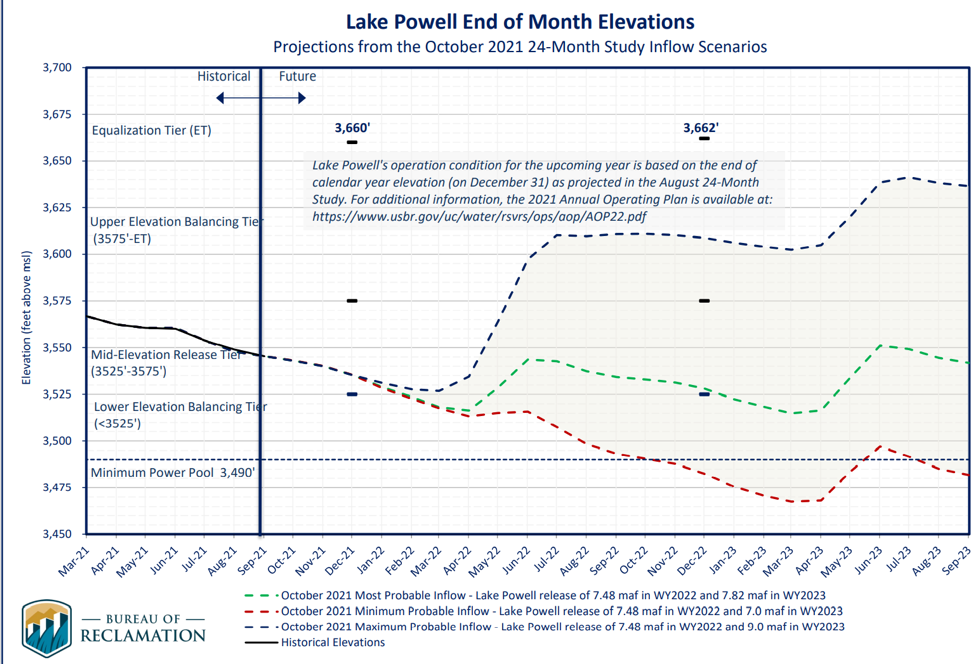
A shrinking Lake Powell
By Eric Kuhn
The latest Bureau of Reclamation monthly Colorado River modeling runs show an even bigger drop over the next year in Lake Powell’s elevation that previously projected. But this is not an example of bad news getting worse. Instead, a change toward a drier baseline hydrology more accurately reflects the drying of the Colorado River basin in the 21st century.
Usually, during the non-snow accumulation and non-run-off forecast seasons (August – December), the Bureau of Reclamation’s 24-month studies change very little from month to month. Today, however, the basin’s nerds (I’m on that list) that closely follow these studies were in for a sobering surprise. All three of the October studies (most probable, minimum probable, and maximum probable) showed a consistent shift to a drier future. The reason for this shift is disclosed in footnote #1 – “The October 2021 24-Month Study includes the Colorado Basin River Forecast Center shift to the 1991-2020 period of record.” In simple terms, out are the wet years from the 1980s and in are the more recent dry years from the 2010s.
This shift to the more recent years is important for several reasons. First, the 1991 -2020 period is likely to be much more representative of the future under climate change driven aridification of the basin. Second, given the depleted state of the system reservoirs, seemingly small changes in storage can have big operational impacts. For example, the September most probable study showed Lake Powell ending Water Year 2022 at elevation 3545’, the October most probable study now shows elevation 3534’. The change is only 11’, but it’s enough to push Lake Powell into the Lower Elevation Balancing Tier for 2023. This means that the projected most probable release from Glen Canyon Dam for Water Year 2023 has gone up from 7.48 maf to 7.818 maf. When Lake Powell is in this bottom tier, the goal is to release between 7 and 9.5 maf/year so as to equalize end of water year storage between Powell and Mead.
For another example, look at the minimum probable studies. The September version shows Lake Powell bottoming out at 3482’ while in the October version it’s 3467’. Again, only a 15’ difference, but since the minimum power elevation is 3490’ it has a big impact on how long the power plant will be unable to produce power. Which in turn has an enormous impact on the Upper Basin Fund cash flow. The September minimum probable showed Glen Canyon Dam not producing power for about 21/2 months. See the graph below, under the October version a Glen Canyon Dam power plant outage could be as long as ten months (if not all year). From a cash flow perspective, the difference is about $200 million.
The shift in the period of record traditionally only happens once per decade. It is a good thing it happened this year. Given what we’ve seen over the last 20 years, the shift will add needed conservatism and urgency to the Basin’s efforts to bring our water use in balance with the available supply.

The Lees Ferry natural flows from 1991-2000 were about 15 million acre feet / year. The last two decades these flows were about 12.5 million acre-feet per year.
It is not clear to me that including the wetter years of the last decade of the twentieth century to predict/model the twenty-first is at all helpful. It increases the odds of continuing to underestimate the risks of climate change.
Its a bit like having a stress test at 11maf when last year came in at 7maf. This does not seem helpful.
AZ pushed too hard for that “Surplus Water” move downstream.
“but it’s enough to push Lake Powell into the Lower Elevation Balancing Tier for 2023. This means that the projected most probable release from Glen Canyon Dam for Water Year 2023 has gone up from 7.48 maf to 7.818 maf. When Lake Powell is in this bottom tier, the goal is to release between 7 and 9.5 maf/year so as to equalize end of water year storage between Powell and Mead.”
So does this mean that they would be ’emptying’ Powell to fill up Mead?